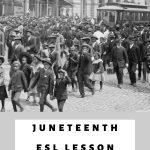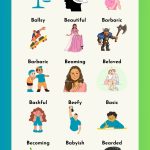Reading is an essential skill that ESL students need to improve their overall English language ability. It is also a key area that ESL beginners focus on a lot and try to develop. A famous quote by Dr. Seuss says, “the more that you read, the more things you know.” and “the more that you learn, the more places you’ll go.” This is such an inspirational quote for ESL students who are having a tough time learning another language. If you want to help your students improve their ESL reading skills, continue reading!
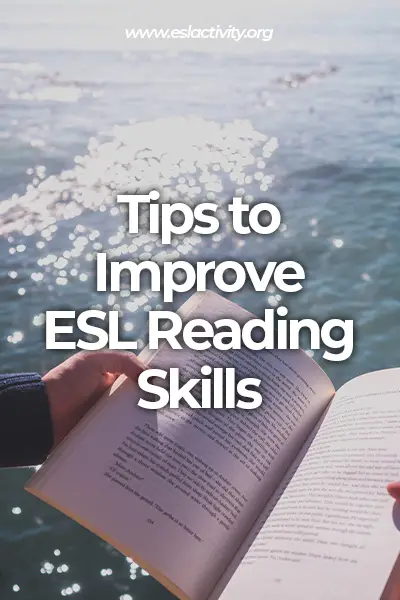
Tips to Improve ESL Reading Skills
ESL Reading Skills
Reading is the basis of other language skills like speaking, listening, and writing. Practicing reading comprehension will naturally help ESL students improve other skills. However, when it comes to reading, simply being able to ‘read’ is not enough.
ESL Reading Comprehension
What is reading comprehension? Reading comprehension is the ability to read, process, and understand the meaning of the text. It is different from simply ‘reading’ because you can read a passage very well and still not understand the meaning behind the text. However, if ESL reading is taught properly, reading comprehension skills will develop altogether.
5 Tips for Developing ESL Reading Skills
Check out the 5 strategies you want to use when teaching an ESL reading class.
1. Scanning
Scanning is a skill that readers have to read quickly to understand the idea. Some people overlook this skill because it is more of a speed-reading skill, but scanning and skimming are two very essential reading skills. For example, ESL students who are planning to take English proficiency exams, like IELTS, need to read a passage within a limited time, understand it, and also answer questions. It is impossible to do this without scanning.
Also, ESL students who are learning business English need to practice scanning. Business reports tend to be very long, and it is hard to figure out which sentences need more attention than the others. Through scanning, readers can identify the important keywords or sentences that require more careful reading.
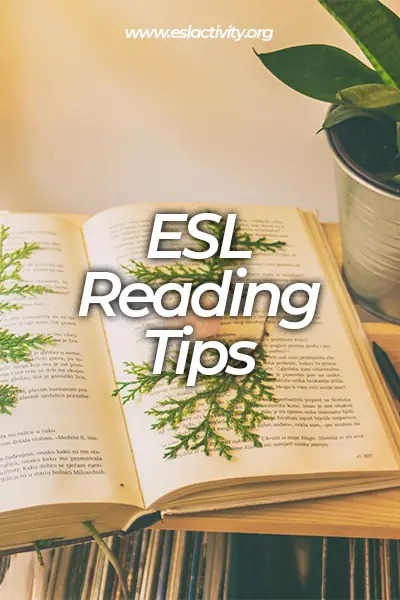
ESL Reading Tips
2. Predicting
A great way to develop your students’ reading comprehension skills is to practice predicting. You can do this easily by giving a paragraph to the students. Make them guess what’s going to happen in the next paragraph. When brainstorming, have your students speak up, so they can think and speak in English while trying to understand the context. Students will have to refer to the provided paragraph to support their idea of what the next paragraph is going to be about.
Also, let them ask questions. If students feel like key information is missing in the given paragraph, let them ask and obtain the necessary information.
3. Summarizing
Summarizing is hard even for native English speakers. But, it is a very critical skill that you want to help your students develop. Summarizing requires understanding the text and briefly explaining in one’s own words. If it is a lower-level ESL class, don’t bother making your students go through the challenge of reading a long paragraph and summarizing it in sentences. You can begin by making your students give a short oral summary. It is a great way to check if your students understood the text.
4. Contextualizing
Help your students place the text within a context. News articles are great for practicing contextualizing skills. Through discussions and group work, make your students think about who the reader is, how the reader is impacted by the story, and how your students can relate to the story.
Let’s say a news article is about the climate change issue in the Arctic. Have your students answer these questions:
- who are the readers? (who cares about this issue?)
- why is this article important?
- what is climate change?
- how is climate change affecting where you live?
5. Discussing
Take your students to the next level through discussions. Create discussion questions for a chosen article (or paragraph). Questions can be easy or controversial (for the extra hype). You can provide multiple choices for the answers. These questions will make students rethink what they have read or even go back to the passage to find the answer.
The discussion-based lesson will not only improve your students’ reading skills but will also help improve speaking and listening skills.
ESL Reading Resources
If you are looking for additional teaching materials for ESL reading, check out these websites.
- English reading books for beginners
- Reading comprehension worksheets
- Breaking News English (news articles with teaching materials)
- Summarizing activities
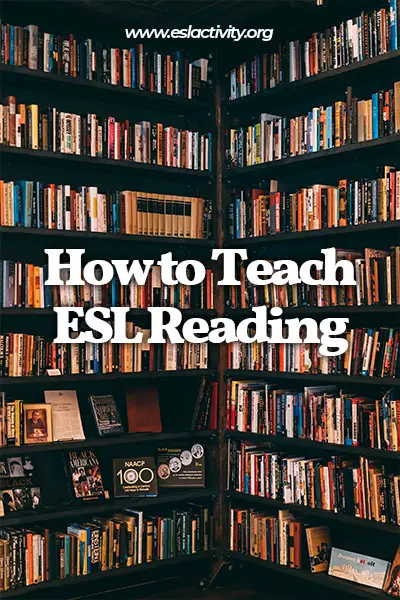
How to Teach ESL Reading
FAQs About ESL Reading Skills
Here are some of the most frequently asked questions about how to develop ESL reading comprehension skills.
How do you teach reading skills in ESL?
Besides reading a lot, which is the most effective way to improve reading skills, the best way to teach reading skills to ESL students is to use games and activities, like dialogue substitution, concentration reading and memory game, odd one out, mixed-up sentences, and information gap activities. The tip for teaching ESL reading is to focus on these five areas: scanning, predicting, summarizing, contextualizing, and discussing.
What are the 5 types of reading skills?
The 5 types of reading skills are phonics, phonemic awareness, vocabulary, reading comprehension, and fluency.
What makes reading difficult for ESL students?
Out of the 5 types of reading skills, fluency is the greatest challenge for ESL students. The lack of proficiency affects the speed of understanding the text. Even someone with a great vocabulary can have a hard time decoding and understanding how the words connect to produce a meaningful message.
More Tips for Improving ESL Reading Comprehension for Adults
Improving reading skills is essential for ESL (English as a Second Language) learners. Here are some tips to help you enhance your reading skills:
Read regularly
Make reading a habit by setting aside dedicated time for it every day. Start with shorter texts and gradually work your way up to longer and more complex ones.
Choose appropriate reading material
Select texts that match your current proficiency level. Look for graded readers or materials specifically designed for ESL learners. This will help you understand the content better and build your confidence.
Activate prior knowledge
Before reading a text, activate your existing knowledge on the topic. Preview the text, scan headings, and think about what you already know. This will help you make connections and improve comprehension.
Improve vocabulary
Enhance your vocabulary by learning new words and phrases. Make a habit of looking up unfamiliar words in a dictionary and keeping a vocabulary journal. Practice using these words in sentences to reinforce your understanding.
Read for the main idea
Focus on understanding the main idea or the central message of the text. Pay attention to the topic sentence, introductory paragraphs, and concluding statements. This will help you grasp the overall meaning.
Develop skimming and scanning techniques
Skimming involves quickly going through the text to get a general idea. Scanning involves searching for specific information. These techniques can help you save time and find relevant information efficiently.
Improve reading speed
Practice reading at a comfortable pace and gradually increase your speed. Avoid subvocalization (pronouncing the words in your head) as it can slow down your reading. Instead, try to absorb the information visually.
Take notes
While reading, jot down key points, main ideas, or unfamiliar words. Summarize the text in your own words to reinforce your understanding and retention of information.
Practice reading aloud
Reading aloud can improve your pronunciation, fluency, and comprehension. It also helps you become more familiar with the natural rhythm and intonation of the English language.
Join a book club or discussion group
Engage in conversations about the texts you read. Joining a book club or discussion group with other ESL learners or native English speakers can provide valuable opportunities for practicing your reading comprehension and language skills.
Tips for ESL Reading Skills: Join the Conversation
What are your thoughts on the top 5 tips for teaching ESL reading skills? What do you think is the most difficult area when it comes to teaching English to ESL students? Let us know in the comments! We’d love to hear from you.

